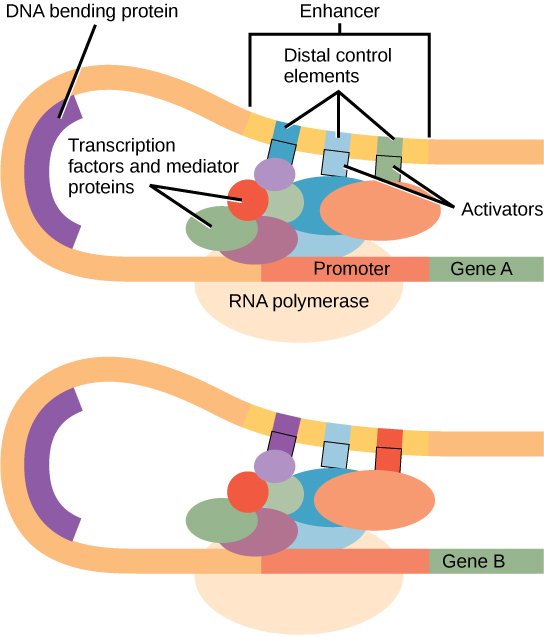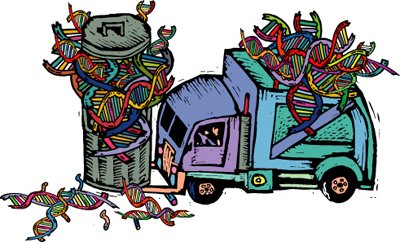“Did you know 98.8% of human DNA is just junk?”
“What do you mean, junk?”
“It doesn’t code for proteins or contains genes. It just does nothing, has no function, that makes it junk, right?”
“Just because it doesn’t code for proteins, does not make it junk. DNA does many things, one of which is protein coding.”
“But I read it, in a study. Only 98.8% of DNA codes for proteins, the rest is non-coding.”
“Exactly! Non-coding. Not junk. Like I said, just because some DNA does not code for proteins, does not make it useless. Obviously, the purpose of DNA is to carry genetic information, which are genes. And these genes code for proteins, and these proteins are the end products of genetic information. But, that isn’t it! DNA has other functions!”
“Well, what are they then?”
There has been much controversy over the uses of non-coding DNA. However, recent research has highlighted many mechanisms by which non-coding DNA can influence the expression of protein coding regions, which would suggest that DNA is not, despite what was originally thought, 98.8% junk. There is no doubt that a large proportion of DNA has no known function, but this may simply because we are yet to discover its actual function. It seems an odd concept that through evolution 98.8% of DNA has been left but it does not carry out any useful task, as this is not usually the way the mechanism of evolution works.
We only need to look as far as protein synthesis in order to realise that the non-coding elements of DNA are extremely important.
In order to initiate transcription of mRNA, the enzyme RNA polymerase must first bind to a promoter region. This is a region of a specific base sequence to which the enzyme will bind, without which transcription can not begin. The promoter sequence exists upstream to the region of DNA containing the gene that codes for the protein, thus it is part of non-coding DNA. Despite this, the promoter is essential to protein synthesis, and without such recognition sites no mRNA would be transcribed and no proteins would be made.
There are also elements within DNA known as enhancers. These elements can influence promoter regions themselves. This allows a finer control on what conditions a protein will be made. Enhancer elements are often thousands of bases away from the coding element of DNA, yet can have an influence on the promoter region. This is another example of non-coding DNA having a great influence on coding regions. It has been speculated that enhancer elements can activate or repress promoter regions through direct contact, which involves the bending of DNA.

figure 2. Proposed enhancer element mechanism of action
Similar to enhancers are response elements. These allow proteins to be made in response to the changing environment. When a hormone is activated, for example, it is able to bind to the response element within DNA. This then causes transcription of specific mRNA to create a protein that will produce an appropriate response to the change in environment triggered by the hormone.
Our last example is microRNA (miRNA). This are small portions of RNA that are transcribed from a non-coding area of DNA. This miRNA can then bind to a portion of transcribed mRNA to either inhibit translation of the protein or trigger the degradation of mRNA. Both have the effect of reducing the amount of overall protein produced.
Recently, data has emerged suggesting that miRNAs are important regulators of disease. Indeed, a number of miRNAs act as tumour suppressors and oncogenes (cancer causing genes). The expression of miRNAs is highly unusual in many human tumours and miRNAs might be used as prognostic and diagnostic tools in the near future.
Hopefully I have highlighted the importance of just some of the non-coding elements of DNA, and proved that they are not just junk, answering the question in the fictional conversation above. In my opinion, many non-coding elements are extremely important to the functions of DNA and without them, the protein end products from the protein coding sequences would not even exist.
References:
Quantity of non-coding DNA
Transcription factors
Promoter sequences
Enhancer elements

Very good, go to my blog too.
@jasonmunapasee
@ovij upvoted
Very good article, I never heard of micro RNA. Thank you for sharing your knowledge with us my friend
No problem, I am glad that you found it interesting. I think miRNA is a relatively new discovery and it's full mechanism of action is undiscovered. Perhaps it holds some exciting prospects for future medicine!
Incredibly interesting and well explained and final compliment, perfect length.
Thought I'd drop by, thanks for the vote on my wee story, it means a lot to know that someone read it and actually voted on it:-)
Thank you very much. I am always happy to support interesting content, and I am glad you enjoyed mine in return!
This post has received a 0.78 % upvote from @drotto thanks to: @banjo.